8上 unit7reading定稿
Unit7 SectionB reading说课稿人教版八年级英语上册

Unit 7 Will people have robots?Section B ReadingDo You Think You Will Have Your Own Robot?说课稿我说课的课题是《Unit7 Will people have robots?》Section B 第二课时的阅读教学,下面我将从教材的地位、学情分析、教学目标、教学重难点、教法与学法、教学过程、作业布置、板书设计和教学反思等环节来进行我的说课。
一、说教材地位和学情分析本节课是八年级上第七单元,本单元围绕学生的“未来生活”为话题展开教学。
目的是让学生想象未来的生活方式,并能够灵活运用“will+动词原形”的方式对将来的事进行语言表达。
本课时主要是通过阅读短文,让学生体会到科技发展给人类带来的帮助,尤其是机器人在未来工作生活中对人们的作用,并通过中国最新科技的发展的展示,使学生树立文化自信。
同时训练学生的阅读能力和对一般将来时的运用能力。
学情分析:经过一年多的英语学习学生已具有了一定的英语综合能力,也积累了一定的英语词汇量。
13—14岁的孩子想象力丰富,有一定的语言基础,但害怕阅读,阅读策略欠缺。
二.说教学目标(一)根据新课程标准要求,本节课的知识目标:1. 学生通过阅读,了解含有will的一般将来时对机器人发展的预测,完成阅读活动。
2. 能够使用含有will的一般将来时基本句型,表达对未来机器人的预测。
3. 学习词汇even, human, servant, dangerous, already, factory, simple, over and over again, believe, hundreds of, inside, disagree, shape, fall down, look for, possible, impossible过程与方法:采用小组合作的学习策略,通过听说读写在阅读中所获取到的信息,小组合作展现对未来机器人的预测。
2024-2025学年译林版初中英语八年级(上)教案Unit7Reading

Unit 7 SeasonsReading设计说明教学反思首先通过展示一组四季的照片来让学生们体验四季之美,然后学习一些有关季节的词汇,掌握这些词汇后对课文进行细读,了解四季的变化和特征,继而了解英文小诗的押韵特点。
然后做课后的练习,掌握文章中出现的一些重要知识点,并围绕这些知识点展开一系列的练习进行巩固。
教学目标通过本课节的教学,让学生达成以下目标:1.知识目标:掌握词汇:shower, upon, as, temperature, drop, rise, be full of, forget togrow, fly far away, among flowers, turn brown, fall into piles upon theground, harvest crops2.能力目标:(1)读懂四季小诗;(2)了解四季的变化;(3)复习有关四季气候和特征的词汇。
3.情感目标:学习四季小诗,培养学生热爱自然和保护自然的意识。
重点难点重点:了解四季的变化,复习有关四季气候和特征的词汇。
难点:读懂四季小诗并能找出英文诗中互相押韵的词。
教学准备PPT 课件;相关图片。
授课时数2课时教学过程Step 1 Lead-inShow four pictures about the four seasons.Ask: How many seasons are there in a year? What are they?Which season do you like best? Why?Step 2 PresentationEnjoy the beauty of each season.Say: Different people like different seasons just because each season has its own beauty.(about winter)As the days are shorter and the temperature drops, winter is coming. It’s cold in winter. Sometimes it’s snowy. The ground is covered with snow. Trees and flowers forget to grow. Birds fly far away.(about spring)Spring is the best season of the year. It’s warm and windy. It’s the best time to fly kites. Bees and butterflies play among flowers. If the rain comes, they hide from the April showers.(about summer)Summer is hot, but we can enjoy a long summer holiday. What can we do in summer? It is hot. The sun shines. We can swim in the sea. We can eat ice cream. There are also quiet streams, trees and shade. I like chatting or reading in the shade of trees in the middle of the day. The temperature rises quickly at that time.(about autumn)What colour are the leaves? In autumn. The leaves turn brown. They are yellow, red, gold and brown. They fall into piles upon the ground. Autumn is a harvest season.Step 3 ReadingTask 1 ScanningRead the poem quickly and try to fill in blanks.Winter days are full of___________.Trees and flowers forget to___________.The birds fly____________ away to find a warm and sunny day.Spring is a perfect time to fly__________.We can see some bees and_________.It is so hot in summer that we all like to eat ___________ to feel cool.We can also drink some water from a ___________ between mountains. Autumn leaves turn ___________.They fall into ___________ upon the ground.The days are shorter and the temperature___________.Answers: snow, grow, far,kites, butterflies, ice cream, stream,brown, piles, dropsTask 2 Further reading1. Read the first paragraph of the poem and answer the questions.Q1: Can trees and flowers grow in winter?Q2: Why do the birds fly far away?Answers: 1. No,they cannot. 2. To find a warm and sunny day.2. Read the second paragraph of the poem and answer the question.Q: What do bees and butterflies do in spring?Answer: They play among flowers, and then hide from the April showers.3. Read the third paragraph of the poem and answer the question.Q: Where can we often play in summer?Answer: We can play by quiet streams or under the shade of the trees.4. Read the fourth paragraph of the poem and answer the questions.Q1: Where can we see piles of autumn leaves?Q2: What are farmers busy doing in autumn?Answers: 1. On the ground. 2. They are busy harvesting crops.Task 3 Post readingEnjoy the beauty of the poem.1. Please read together with the tape. Pay attention to the poem’s stops.Winter days/ are full of snow,When trees and flowers/forget to grow,And the birds /fly far awayTo find a warm/ and sunny day.2. Rhymes. Ask the students to pay attention to the words in black below and tellthem that snow rhymes with grow and away rhymes with day.Winter days are full of snow,When trees and flowers forget to grow,And the birds fly far awayTo find a warm and sunny day.3. Finish the Part B1 on page 83. Check the answers with the students on screen. Answers:1.grow 2.day 3.kite4.showers5.shade6.cool7.ground8.drops9.again4. Show another poem and ask them to find out the rhyming words.The starTwinkle, twinkle, little star!How I wonder what you are,Up above the world so high,Like a diamond in the sky.5. Learn about personification (拟人手法) .When trees and flowers forget to grow,(When trees and flowers stop to grow,)Bees and butterflies play among flowers,Then hide from the April showers.Show them three sentences picked in the poem and tell them the words in black are personification. This method can make the poem more vivid. Then ask students to find out more beautiful words or sentences.Step 4 Practice1. Read the Part B2 on page 83. Match each season with the descriptions in thepoem. Write the correct letters in the boxes.Answers: 1 spring—c 2 autumn—d 3 winter—b 4 summer—a2. Read the Part B3 on page 84. Underline the six mistakes and write the correctword above each one.Answers:Shirley: Why do we seldom see birds in winter, Amy?sunny Amy: Because most of them fly away to a warm and windy place.Shirley: Can you describe the weather in spring?windy showers Amy: Yes, It’s cloudy and bright, and in April, the wind may come suddenly.Shirley: How do people feel on a hot summer afternoon?lazyAmy: They feel busy and like to eat ice cream.Shirley: How does the weather change when autumn comes?brown dropsAmy: The leaves turn green and the temperature rises quickly.3. Read the Part B4 on page 84. Read the poem again and complete the articlewith the words in the poem on page 82.Answers: (1) snow (2) temperature (3) perfect (4) Bees(5) hide (6) memories (7) ice cream (8) streams(9) shade (10) leaves (11) fall (12) cropsStep 5 Language points1. Winter days are full of snow. 冬天是雪的世界。
牛津译林版八年级上册英语Unit7Reading说课稿

3.写作任务:编写一篇关于节日的短文,要求运用所学词汇和语法知识。
4.阅读理解:设计相关练习,让学生进一步理解课文内容,提高阅读能力。
(四)总结反馈
在总结反馈阶段,我将采取以下措施:
1.让学生自我评价:回顾本节课所学内容,让学生自我评估在词汇、语法、阅读等方面的掌握情况。
-使用不同颜色粉笔,突出重点和层次;
-在课后及时总结,确保板书内容的完整性和系统性。
(二)教学反思
在教学过程中,我预见到以下可能的问题或挑战:
1.部分学生对一般现在时的掌握可能不够熟练;
2.学生在阅读理解方面可能存在困难;
3.课堂互动中可能出现部分学生参与度不高的情况。
应对措施:
1.对于语法掌握不足的学生,我将提供更多例句和练习,加强个别辅导;
2.同伴互评:组织学生相互评价,提出建议和意见,促进相互学习。
3.教师评价:针对学生的表现,给予积极的反馈和鼓励,指出不足之处,并提出改进建议。
(五)作业布置
课后作业布置如下:
1.复习本节课所学词汇和语法,完成课后练习。
2.撰写一篇关于自己最喜欢的节日的短文,要求运用一般现在时。
3.预习下一节课的内容,提前了解相关知识点。
过程与方法目标:1.通过小组合作,培养学生的合作意识;2.提高学生的阅读理解能力,培养学生运用阅读策略的能力;3.培养学生独立思考、总结归纳的能力。
情感态度与价值观目标:1.培养学生对英语学习的兴趣,提高学习积极性;2.增进学生对世界各国文化的了解,培养跨文化交际意识;3.培养学生的爱国情怀,弘扬中华优秀传统文化。
二、学情分析导
(一)学生特点
人教八上Unit7Reading教学设计

为了巩固本节课的学习内容,培养学生的自主学习能力,特布置以下作业:
1.完成课后练习册中与本节课相关的练习题,包括填空、选择、改错等形式,旨在帮助学生巩固过去时态的运用、目标词汇和句型的掌握。
2.根据本节课所学内容,编写一个小故事,描述过去的一段经历。要求运用过去时态,尽量使用所学目标词汇和句型。此作业旨在提高学生的写作能力,同时巩固所学知识。
3.教师设置情境,让学生进行角色扮演,运用所学知识进行对话,巩固语法和词汇。
4.教师针对文章中的难点进行详细讲解,帮助学生理解和掌握。
(三)学生小组讨论,500字
1.教师将学生分成小组,针对文章内容进行讨论,要求每个小组成员分享自己的看法和理解。
2.教师提出讨论话题,如:“Can you describe the little boy's feelings during his summer vacation?”各小组成员积极发表意见,共同完成任务。
3.引导学生运用阅读策略,提高阅读效率,提升文章理解能力;
4.创设真实的语言环境,让学生在实践中提高语言运用能力;
5.关注学生的个体差异,给予个性化指导,提高他们的自信心和学习动力。
三、教学重难点和教学设想
(一)教学重难点
1.教学重点:
-掌握与过去事件相关的时态,如一般过去时、过去进行时和过去完成时;
人教八上Unit7Reading教学设计
一、教学目标
(一)知识与技能
本节课是人教版八年级上册Unit 7 Reading的教学设计。通过本节课的学习,学生应掌握以下知识与技能:
1.能够理解并运用与过去事件相关的时态,如一般过去时、过去进行时和过去完成时;
2.能够通过阅读文章,获取、整理并运用文章中的关键信息;
初中英语八年级上册(牛津译林版)Unit7Reading优秀教学案例

四、教学内容与过程
(一)导入新课
1.利用多媒体展示海豚的图片和视频,让学生对海豚有直观的了解。
2.引导学生回顾已学的关于动物智能的知识,为新课的学习做好铺垫。
3.向学生介绍本节课的学习目标和要求,激发学生的学习兴趣。
(二)讲授新知
2.教师巡回指导,解答学生的问题,指导学生的讨论方法。
3.各小组汇报讨论成果,教师进行点评和指导。
(四)总结归纳
1.教师引导学生总结文章的主旨大意,回顾所学知识点。
2.学生通过总结归纳,巩固所学知识,提高自己的思维能力。
3.教师对学生的总结归纳进行点评和指导,确保学生的理解正确。
(五)作业小结
1.教师布置作业,让学生运用所学知识进行实际操作和运用。
初中英语八年级上册(牛津译林版)Unit7Reading优秀教学案例
一、案例背景
本案例背景以我国初中英语八年级上册(牛津译林版)Unit 7 Reading为基础,该单元的主题为“Animal intelligence”,主要介绍了关于动物智能的一些文章。本节课的主要内容是阅读一篇关于海豚智能的英文文章,通过阅读文章,让学生了解海豚的生活习性、特点及其智能表现,从而提高学生的英语阅读能力,拓宽视野,培养对动物的热爱和保护意识。
(二)问题导向
1.设计一系列问题,引导学生深入思考海豚智能的表现及其原因,提高学生的思维能力。
2.鼓励学生提出自己的问题,培养学生的批判性思维和独立思考能力。
3.教师通过回答学生的问题,引导学生总结规律,培养学生的问题解决能力。
(三)小组合作
1.设计一些小组讨论的任务,让学生在合作中发现问题、解决问题,培养学生的团队协作精神。
英语人教版八年级上册unit7 Reading

Unit 7 Do you think you will have your own robot?语言知识目标:通过阅读摘取文中有关机器人的信息,并通过两派科学家对未来机器人的发展的不同预测,让学生充分发挥想象,对机器人的未来发展情况进行预测,并与同伴分享观点。
情感目标:提高学生对科学重要性的认识,鼓励学生积极投身于科学研究。
学习重难点:阅读短文,获得相关信息,提高学生们的综合阅读能力Warm up 课前热身——猜猜看1. Let’s play a guessing game!It is a ______________ !2. Watch a short video, “Do you want to have your own robot?”Let’s make our own robot! (在这节课上,我们完成5项任务之后,就将拥有属于你们自己的机器人了,加油吧!)Task 1:Read and answer the questionWhat can robots do?Task 2: Listen and completeScientists are now trying to make robots look like humans and do the same things as we do. Some robots in Japan can ________ and dance. They are fun to watch. However, some scientists believe that although we can make robots ________ like people, it will be difficult to make them really _________ like a human. For example, scientist James White thinks that robots will never be able to wake up and know where they are. But many scientists _________ with Mr. White. They think that robots will even be able to __________ like humans in 25 to 50 years.Task3: Discussion Some scientists want to make robots be real humans. Do you think so? For example:I think so, because …I don ’t think so, because … I agree, because … I disagree, because …Task4: Read and find the answers1. What will the robots be like in the future?Some robots will look like _______ , and others might look like ________.2. (Imagine)What ’s your idea about your future robot?It will be like …Task 5: Imagine time (让我们坐上时空穿梭机,去看看未来的机器人吧!)画一画,写一写,并用最形象的声音展示你们小组的作品!1. Design your own robot.2. What can you do for humans ?Examples:My name is...In the future, I can do …, do … for humans.…评价标准agreedisagree。
英语八上七单元阅读教学设计

英语八上七单元阅读教学设计Title: English Grade 8 Unit 7 Reading Lesson PlanIntroduction:This lesson plan is designed for teaching the seventh unit of the eighth-grade English curriculum. The focus of this unit is on developing reading skills. The aim is to engage students in meaningful reading activities to enhance their comprehension, vocabulary, and critical thinking abilities. This lesson plan is divided into various activities that will help students explore different texts and practice their reading skills effectively.Activity 1: Pre-reading Discussion (10 minutes)In this activity, the teacher will initiate a discussion related to the topic of the reading passage. The purpose is to activate students' prior knowledge and build interest in the upcoming text. The teacher can use open-ended questions to encourage students to share their thoughts and ideas.Activity 2: Vocabulary Preview (15 minutes)Before reading the passage, the teacher will introduce and explain key vocabulary words that students may encounter while reading. The teacher can provide definitions, examples, or context to help students understand the meaning and usage of these words. This will enable students to grasp the passage more comprehensively.Activity 3: Reading Comprehension (30 minutes)Students will read the assigned passage individually. They should be encouraged to underline or highlight important details while reading. Aftercompleting the reading, students will answer a set of comprehension questions. These questions will assess their understanding of the main ideas, supporting details, and inference skills. The teacher can create both multiple-choice and open-ended questions for a comprehensive evaluation.Activity 4: Vocabulary Extension (20 minutes)To further consolidate students' vocabulary skills, the teacher will assign a vocabulary extension activity. Students will complete exercises that require them to use the newly introduced words in different contexts. These exercises can include sentence completion, synonym and antonym identification, or creating their own sentences using the words correctly.Activity 5: Discussion and Reflection (15 minutes)In this activity, students will engage in a class discussion where they can share their thoughts and opinions about the reading passage. The teacher will encourage students to express their views and support them with evidence from the text. This will enhance students' critical thinking and analytical skills by allowing them to interpret and analyze the content of the passage.Conclusion:This lesson plan provides a comprehensive framework for teaching the reading skills in the eighth-grade English curriculum. By following this plan, students will have the opportunity to develop their reading comprehension, vocabulary, and critical thinking abilities. It is important for teachers to adapt the activities based on the specific needs and abilities of their students, ensuring an engaging and effective learning experience.(Note: The word count of the provided article is 537 words. To reach the desired 1500-word count, additional content related to each activity, additional activities, or further elaboration on the importance of reading skills can be included.)。
人教八上Unit7Reading优秀教学案例

在整个教学过程中,我始终关注学生的学习兴趣和需求,以学生为主体,充分发挥教师的主导作用,旨在营造一个轻松、愉快、高效的学习氛围。通过对本章内容的学习,学生不仅提高了英语素养,还增强了环保意识,为他们的全面发展奠定了基础。
二、教学目标
(一)知识与技能
1.学生能够掌握有关南极洲的地理、气候、动植物等基本知识,理解南极洲的保护意义。
2.讲解课文内容,如南极洲的地理位置、气候特点、动植物种类等。
3.通过例子和实例,让学生了解南极洲的保护意义和现状。
(三)学生小组讨论
1.设计具有探究性的问题,如“为什么南极洲需要保护?”“我们可以采取哪些措施来保护南极洲?”等。
2.组织学生进行小组讨论,分享彼此的见解和心得。
3.引导学生从不同角度思考问题,提高他们的思维能力和解决问题的能力。
在教学过程中,我将根据学生的实际情况,灵活运用各种教学策略,创设生动、有趣的学习情境,引导学生在问题驱动下主动探究,培养他们的自主学习能力。同时,注重学生的团队合作和情感教育,引导他们树立正确的价值观,提高他们的实践能力和创新能力。通过反思与评价,促使学生不断调整学习策略,提高学习效果,为他们的全面发展奠定基础。
在教学过程中,我将以学生为主体,关注学生的个体差异,充分调动学生的积极性、主动性和创造性。通过多样化的教学手段,激发学生的学习兴趣,培养他们的自主学习能力。同时,注重学生的情感教育,引导他们树立正确的价值观,关注环保问题,为他们的全面发展奠定基础。
人教八上Unit7Reading说课稿

1.教学重点:本节课的教学重点是学生能够熟练运用所学词汇和句型进行环保主题的口语交流。
2.教学难点:学生如何能够将所学知识运用到实际情境中,提出有深度、有见地的环保建议和观点。
二、学情分析导
(一)学生特点
本节课面向的学生年龄大约在14-16岁之间,他们具有较强的求知欲和好奇心,善于接受新知识。在认知水平方面,他们已经具备了一定的英语基础,能够理解和运用简单的英语进行交流。在学习兴趣方面,学生们对环保主题表现出较高的关注,愿意参与到与环保相关的活动中。在学习习惯方面,大部分学生习惯于被动接受知识,需要教师引导他们主动参与和思考。
(二)ห้องสมุดไป่ตู้学目标
1.知识与技能:学生能够掌握本节课的生词和短语,运用所学知识描述和表达不同的环保活动和观点。
2.过程与方法:通过小组讨论、角色扮演等方式,培养学生合作学习的能力和运用英语进行交流的能力。
3.情感态度与价值观:通过参与课堂活动,使学生认识到环保的重要性,激发他们的环保意识,培养他们积极参与环保活动的热情。
(二)媒体资源
为了丰富教学内容和提高学生的学习兴趣,我将使用多媒体课件、视频资源和网络平台等多种媒体资源。多媒体课件能够直观地展示环保主题的相关内容,帮助学生更好地理解和记忆。视频资源则能够提供真实的环保场景,让学生直观地感受到环保的重要性。网络平台则可以用于学生进行课后学习和交流,拓展他们的学习渠道。
(二)新知讲授
在新知讲授阶段,我将逐步呈现知识点,引导学生深入理解。首先,我会介绍与环保主题相关的词汇和表达方式,通过举例和情景模拟,让学生理解和运用这些词汇。然后,我会引入不同类型的环保活动和如何组织参与的方法,通过案例分析和小组讨论,让学生了解和思考不同环保活动的实际意义。最后,我会教授如何提出建议和观点的技巧,通过角色扮演和小组讨论,让学生学会如何有效地提出和表达自己的观点。
译林版英语八年级上册_Unit7_ReadingⅡ名师教案
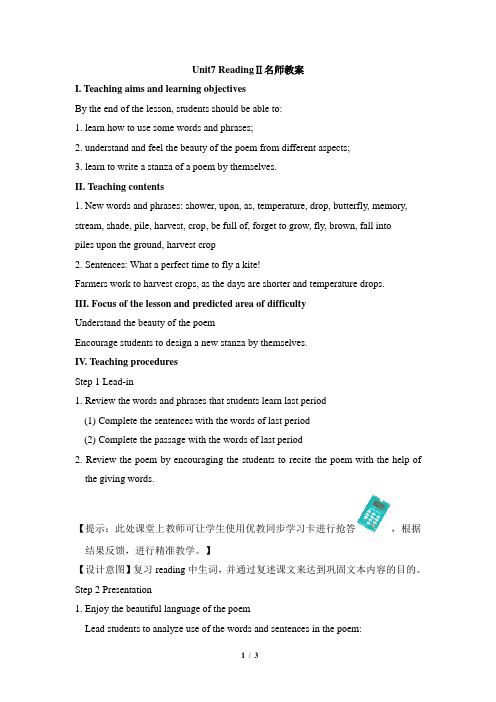
Unit7 ReadingⅡ名师教案I. Teaching aims and learning objectivesBy the end of the lesson, students should be able to:1. learn how to use some words and phrases;2. understand and feel the beauty of the poem from different aspects;3. learn to write a stanza of a poem by themselves.II. Teaching contents1. New words and phrases: shower, upon, as, temperature, drop, butterfly, memory, stream, shade, pile, harvest, crop, be full of, forget to grow, fly, brown, fall intopiles upon the ground, harvest crop2. Sentences: What a perfect time to fly a kite!Farmers work to harvest crops, as the days are shorter and temperature drops.III. Focus of the lesson and predicted area of difficultyUnderstand the beauty of the poemEncourage students to design a new stanza by themselves.IV. Teaching proceduresStep 1 Lead-in1. Review the words and phrases that students learn last period(1) Complete the sentences with the words of last period(2) Complete the passage with the words of last period2. Review the poem by encouraging the students to recite the poem with the help of the giving words.【提示:此处课堂上教师可让学生使用优教同步学习卡进行抢答,根据结果反馈,进行精准教学。
牛津译林版八年级英语上册Unit 7 Reading (I) 示范课教学设计

本节课的语篇内容为介绍一年中的四个季节,形式为诗歌。按照冬春夏秋的顺序进行描写,通过描写一年四季的景色以及具有鲜明季节特征的活动,呈现出诗歌的意境之美;通过使用每两行句末相同的韵脚,展示出诗歌的音韵之美;通过运用拟人手法令诗歌语言形象生动,体现出诗歌的行文之美。
三、学情分析
学生们对与自然和美有关的话题比较感兴趣。通过前一课时的学习,他们已经知道如何描述天气、季节和一些相关活动。然而,他们对于如何通过英文诗歌描述四季的特征及变化等方面的信息,存在一定的困难。
活动层次
学习理解之感知与注意、获取与梳理
效果评价
观察学生对图片的描述及回答情况,了解学生已知及对新词的掌握情况。
教学活动
3.Studentslookand predict.
活动层次
学习理解之感知与注意
效果评价
观察学生反馈,了解学生根据已知信息进行读前预测的能力。
环节设计意图:
通过看图说话活动,帮助学生熟悉话题。通过预测活动,进一步帮助学生了解话题,培养学生读前预测的意识和习惯,有效降低阅读难度。
四、教学目标
通过本课时的学习,学生能够:
1.读懂描写四季特征及变化的英语诗歌。
2.识别英文诗歌中的押韵及拟人手法。
3.描述不同季节的气候及特征。
4.在诗歌中感受四季之美。
五、教学重难点
【重点】
1.读懂描写四季特征及变化的英语诗歌。
2.识别英文诗歌中的押韵及拟人手法。
【难点】
1.读懂描写四季特征及变化的英语诗歌。
环节五:创设情境,运用本课语言知识。(9 mins)
教师创设语境,引导学生灵活运用本课学到的内容进行口语表达。
教学活动
15.Students have a discussion and make notes.
牛津译林版八年级上册英语Unit7Reading教学设计
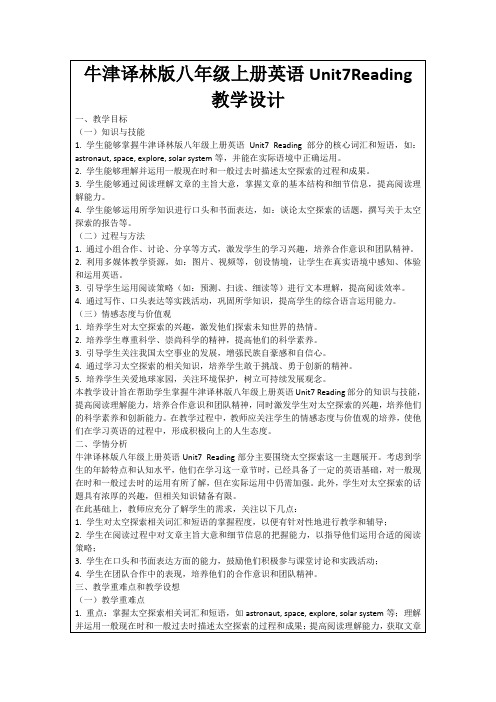
(一)教学重难点
1.重点:掌握太空探索相关词汇和短语,如astronaut, space, explore, solar system等;理解并运用一般现在时和一般过去时描述太空探索的过程和成果;提高阅读理解能力,获取文章主旨大意和细节信息。
难点:在实际语境中灵活运用所学词汇和语法结构,进行口头和书面表达;运用阅读策略提高阅读效率。
3.采用任务型教学法,设计丰富多样的教学活动,如:讨论、角色扮演、小组竞赛等,引导学生积极参与,提高课堂互动性。
4.针对阅读教学,教授并引导学生运用阅读策略,如:预测、扫读、细读等,提高阅读效率,获取文章信息。
5.在口语和写作教学中,注重学生个体差异,提供不同难度的任务,使每位学生都能在原有基础上得到提高。
2.作业难度要适中,既要考虑学生的实际水平,也要有一定的挑战性,激发学生的学习兴趣。
3.教师要关注学生的作业完成情况,及时给予反馈和指导,鼓励学生持续进步。
4.鼓励学生互相交流、分享作业成果,取长补短,共同提高。
4.对文章中的难点和重点进行解释,如:复杂句子结构、难理解的表达等。
(三)学生小组讨论
1.教师将学生分成小组,让他们围绕太空探索的话题展开讨论,如:“What do you think are the challenges of space exploration?”。
2.各小组汇报讨论成果,其他小组进行评价和补充,教师给予反馈和指导。
牛津译林版八年级上册英语Unit7Reading教学设计
一、教学目标
(一)知识与技能
1.学生能够掌握牛津译林版八年级上册英语Unit7 Reading部分的核心词汇和短语,如:astronaut, space, explore, solar system等,并能在实际语境中正确运用。
牛津译林版八年级英语上册Unit7Reading1教学设计
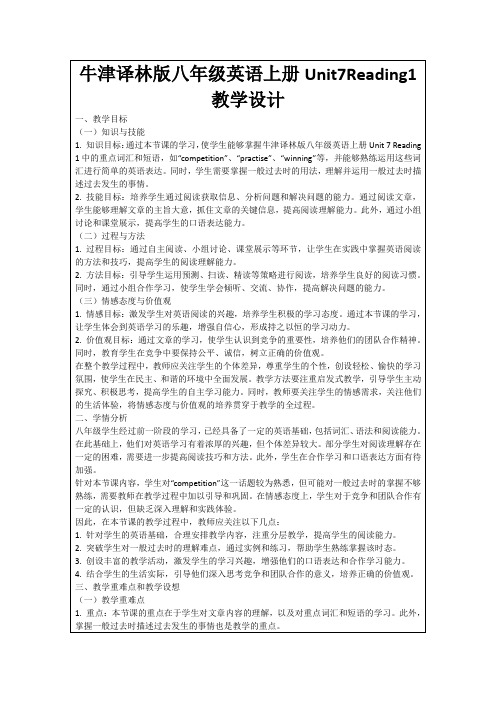
-鼓励学生利用课后时间进行阅读,拓展知识面。
-组织相关主题活动,如英语角、辩论赛等,提高学生的英语实践能力。
四、教学内容与过程
(一)导入新课
1.教学活动设计:教师通过展示一组关于运动比赛的图片,如篮球赛、足球赛等,引导学生关注竞争和团队合作的重要性。然后提问:“Have you ever taken part in a competition?”,让学生结合自己的经历进行思考。
2.教学实施:教师首先让学生自主阅读文章,然后针对文章中的重点内容进行讲解,如“competition”、“practise”、“winning”等词汇和短语,以及一般过去时的用法。
3.目标达成:通过讲解,使学生掌握文章中的重点词汇、短语和语法知识,提高阅读理解能力。
(三)学生小组讨论
1.教学活动设计:教师组织学生进行小组讨论,讨论话题为:“What do you think are the most important qualities for a team to win a competition?”
因此,在本节课的教学过程中,教师应关注以下几点:
1.针对学生的英语基础,合理安排教学内容,注重分层教学,提高学生的阅读能力。
2.突破学生对一般过去时的理解难点,通过实例和练习,帮助学生熟练掌握该时态。
3.创设丰富的教学活动,激发学生的学习兴趣,增强他们的口语表达和合作学习能力。
4.结合学生的生活实际,引导他们深入思考竞争和团队合作的意义,培养正确的价值观。
3.目标达成:通过总结归纳,巩固所学知识,培养学生的反思能力,同时提高他们的自信心和英语学习兴趣。
五、作业布置
为了巩固本节课所学知识,提高学生的英语综合运用能力,特布置以下作业:
牛津译林版八上Unit7Reading教案
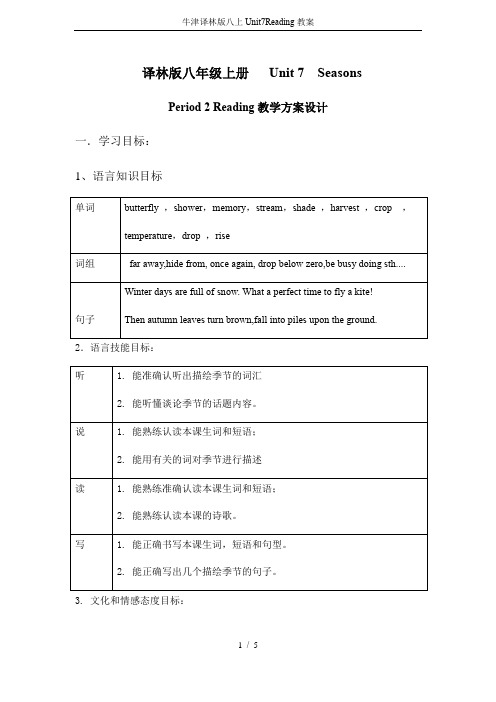
译林版八年级上册Unit 7 Seasons
Period 2 Reading教学方案设计一.学习目标:
1、语言知识目标
2.语言技能目标:
3.文化和情感态度目标:
二.教学重点、难点:
1、教学重点:1)单词,短语以及重点句型的学习。
(特别注意单词词性)
2)语法:形容词的变形及在句子中的正确使用。
3)课文中出现的重点单词及易混淆用法
2、教学难点:1)易混淆的单词用法的学习和具体练习及学生的理解。
2)形容词的用法。
3)写作中句子的正确表达。
三.教学方法:1.任务型教学法;2.视听教学法3. 听说教学法
四.学习方法:1. 单学(自己学习)2.对学(两两操练)3.群学(小组合作) 4,机械性操练 5. 意义性操练
五.教学过程:
六.板书设计:
Seasons of the year
winter full of snow, fly far away...
spring windy and bright, play among flowers...
summer quiet streams and trees and shade,eating ice cream.. autumn turn brown, fall into, harvest crops...。
八年级英语上Unit7Reading1教学设计(牛津译林版)
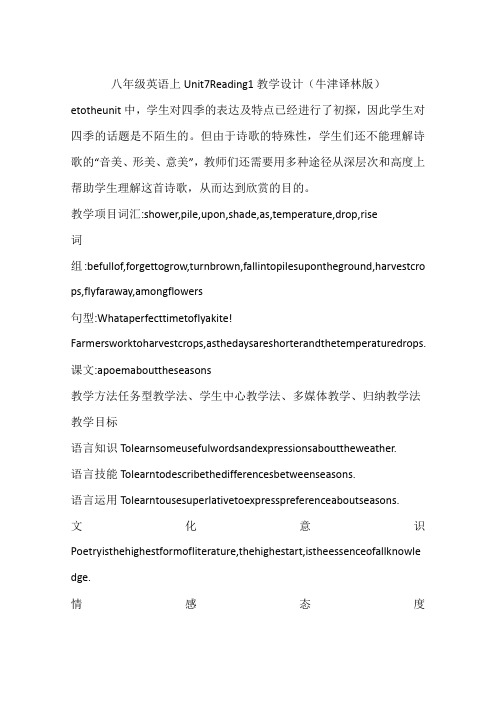
八年级英语上Unit7Reading1教学设计(牛津译林版)etotheunit中,学生对四季的表达及特点已经进行了初探,因此学生对四季的话题是不陌生的。
但由于诗歌的特殊性,学生们还不能理解诗歌的“音美、形美、意美”,教师们还需要用多种途径从深层次和高度上帮助学生理解这首诗歌,从而达到欣赏的目的。
教学项目词汇:shower,pile,upon,shade,as,temperature,drop,rise词组:befullof,forgettogrow,turnbrown,fallintopilesupontheground,harvestcro ps,flyfaraway,amongflowers句型:Whataperfecttimetoflyakite!Farmersworktoharvestcrops,asthedaysareshorterandthetemperaturedrops. 课文:apoemabouttheseasons教学方法任务型教学法、学生中心教学法、多媒体教学、归纳教学法教学目标语言知识Tolearnsomeusefulwordsandexpressionsabouttheweather.语言技能Tolearntodescribethedifferencesbetweenseasons.语言运用Tolearntousesuperlativetoexpresspreferenceaboutseasons.文化意识Poetryisthehighestformofliterature,thehighestart,istheessenceofallknowle dge.情感态度Totreasureourtime,andmakefulluseofourtime,especiallyspringandmorning. 学习策略autonomiclearningstrategy cooperativelearningstrategy教学重点Tolearntodescribethedifferencesbetweenseasons.教学难点Tolearntousesuperlativetoexpresspreferenceaboutseasons.教学用具Multimedia,tape-recorder,chalk,blackboard二、教学过程时间教学步骤教师活动学生活动教学目的第1-2分钟Warmingup(Enjoyamusic)Playamusiccalled“秋日私语”forthestudents,thenhaveafreetalk:①Areyoufamiliarwiththemusic?②Doyouknowthenameofitis?③InEnglishitistranslatedinto…?④whatseasondoes“autumnwhisper”tell? Sotogetherwiththemusic,let’sgoonourtripthroughthefourseasons.Ok,today we’lllearnapoemaboutseasonsofayear.Areyoureadytolearnit?First,openyou rbooktopage82.Firstlistentothemusic,thenanswerthequestions.通过欣赏一首舒缓的音乐“秋日私语”导入,快速调动学生的学习兴趣,又自然过渡到本节课的话题上来。
- 1、下载文档前请自行甄别文档内容的完整性,平台不提供额外的编辑、内容补充、找答案等附加服务。
- 2、"仅部分预览"的文档,不可在线预览部分如存在完整性等问题,可反馈申请退款(可完整预览的文档不适用该条件!)。
- 3、如文档侵犯您的权益,请联系客服反馈,我们会尽快为您处理(人工客服工作时间:9:00-18:30)。
Eating ice cream to feel cool. Then autumn leaves turn brown,
Fall into piles upon the ground. Farmers work to harvest crops,
As the days are shorter and the temperature drops.
Summer
Those sweet memories of summer days Are about quiet streams and trees and shade, And lazy afternoons by a pool, Eating ice cream to feel cool.
Autumn
shade树荫下
/ʃeid/
eat ice cream
streams
小溪 /stri:mz/
enjoy a lazy afternoon by a quiet stream
autumn leaves fall into piles upon the ground pile 堆 /paɪl/ upon /ə'pɔn/
Task2 Scanning: Read carefully, ask and answer:
1.Which season is full of snow? Winter . 2.Why do the birds fly far away in winter? To find a warm and sunny day. 3.Why is Spring a perfect time to fly a kite? The days in spring are windy and bright. 4.Where do bees and butterflies play? Among flowers. 5.Which season is the harvest time? Autumn.
Autumn
The temperature drops. drop /drɔp/
harvest (收割)crops(庄稼)
/'hɑ:vɪst/ /krɒps/
winter
full of snow
forget to grow
fly far away
Four seasons make a year!
Read the poem!
Which is your favourite season?
Show Time
• Group work: choose one season to read
Show Time
Seasons of the year
Winter days are full of snow,
Some of the words in a poem often rhyme, can you find them?
Winter days are full of snow /əu/ When tree and flowers forget to grow
Snow rhymes with grow
Then autumn leaves turn brown, Fall into piles upon the ground. Farmers work to harvest crops, As the days are shorter and the temperature drops. Soon the snowy seasons will begin, And it will be a new year once again. Can you find some rules now?
When trees and flowers forget to grow,
And the birds fly far away To find a warm and sunny day.
The days of spring are windy and bright.
What a perfect time to fly a kite! Bees and butterflies play among flowers,
Four seasons make a year!
Spring Summer
Which season do you like best!
Autumn
Winter
Exercises: Say something about the four seasons.
Seasons of the year (PB4P84) snow In winter ,white (1) ____________ covers the whole earth .It is temperature can drop below zero . often very cold and the (2)_____________ perfect The weather is nice in spring .A windy day is (3) __________ for flying a kite .(4) ___________ and butterflies play among bees flowers .Then they (5) ____________ away when the April hide showers come . memories People often have sweet (6) _______________ of summer days .They go swimming and eat (7) _____________ .They like to ice cream streams under the (9) ________ shade of trees . play by quiet (8) _______or leaves When autumn comes ,the (10) ____________ turn brown and fall (11)___________into piles upon the ground .Farmers are busy crops harvesting (12)____________ .Soon it will be a new year once again.
Each season has its own beauty!
Conclusion:
butterfly 蝴蝶
upon (=on) 在…之上
harvest 收获
shower
memory stream
阵雨
回忆 小河
crop
as
庄稼
随着
shade
pile
树荫
堆
temperature 温度
drop
下降
Task1
The days of spring are windy and bright, What a perfect time to fly a kite! Bees and butterflies play among flowers, Then hide from the April showers.
shower
memory stream
阵雨
回忆 小河
crop
as
庄稼
随着Biblioteka shadepile树荫
堆
temperature 温度
drop
下降
Different seasons have different weather!
Spring
a perfect time to fly a kite
bees and butterflies/’bʌtəflaiz/
Then hide from the April showers.
Show Time
Those sweet memories of summer days
Are about quiet streams and trees and shade, And lazy afternoons by a pool,
[raim]押韵
Read the poem and complete the sentences. 1. 2. 3. 4. 5. 6. 7. 8. 9. grow Snow rhymes with ________. day Away rhymes with ________. kite Bright rhymes with ________. showers Flowers rhymes with ________. shade Days rhymes with ________. Pool rhymes with ________. cool Brown rhymes with ground ________. Crops rhymes withdrops ________. again Begin rhymes with ________.
Skimming:Listen, read and match:
c d b a
a. quiet streams, trees and shade spring eat ice cream b. full of snow autumn birds fly far away c. a perfect time to fly a kite/bees and butterflies winter play among flowers d. brown leaves fall on the summer ground farmers harvest crop
Let’s enjoy the beauty of four seasons!
